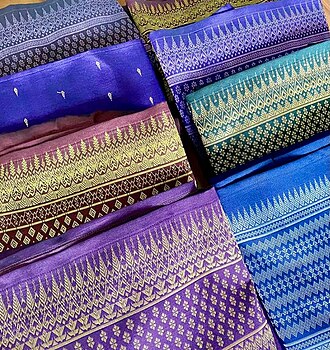Cambodia , officially the Kingdom of Cambodia, is a country located in the southern portion of the Indochinese Peninsula in Southeast Asia. It is 181,035 square kilometers (69,898 square miles) in area, bordered by Thailand to the northwest, Laos to the north, Vietnam to the east and the Gulf of Thailand to the southwest. Phnom Penh is the nation's capital and largest city. The sovereign state of Cambodia has a population of over 15 million. Buddhism is enshrined in the constitution as the official state religion, and is practiced by more than 97% of the population. Cambodia's minority groups include Vietnamese, Chinese, Chasm and 30 hill tribes. The capital and largest city is Phnom Penh, the political, economic and cultural Centre of Cambodia. The kingdom is an elective constitutional monarchy with a monarch, currently Norodom Simoni, chosen by the Royal Council of the Throne as head of state. The head of government is the Prime Minister, currently Hun Sen, the longest serving non-royal leader in Southeast Asia, ruling Cambodia since 1985.
Cambodia: Culture and Tradition
The Art Music and Dance

Music occupies a prominent place in traditional Khmer culture. It is sung and played everywhere - by children when played by adults at work, by men and women while out for a walk - and is always part of many celebrations and festivals that take place. Throughout the year at a Buddhist pagoda in the countryside. Traditional bands distinguished by their instruments include various combinations of wooden flutes and musical instruments, percussion and percussion instruments, zithers, xylophones and metallophones, orchestras and drums of different sizes. Players followed the lead of a device, often a silo phone, and modified their own creations from the aquarium with simple melodies and rhythms.
Dance and theater are important forms of artistic expression. Royal Ballet in Phnom Penh specializes in high-style Aspera dance as well as theatrical dances about the epic Reamker (Ramayana) and other fairy tales. Those forms have been adapted for centuries, both Khmer and Thai, from the ancient Angkorian dances. In the countryside, other types of theater and folk dances are performed at festivals and weddings by wandering groups. Classical ballet, re-created in the early 1980s by surviving dancers, has become highly acclaimed and successfully visited abroad. Princess Ream Norodom Sihanouk, Princess Bopha Devi, a former actress in the Royal Theater, actively supported the revival of classical dance during her tenure as Minister of Culture in the early 21st century. The Royal University of Fine Arts was instrumental in the revival of Khmer classical music and dance after the virtual destruction of the 1970s. Overseas Cambodian communities have also established schools and cultural institutions to help preserve those traditions.
Religion
Cambodia is predominantly Buddhist, with 80% of the population practicing Theravada Buddhism, Christianity 1%, and the rest of the population practicing Islam, selfishness or religion. Buddhist nuns in Angkor Wat, Siem Reap, Cambodia. Buddhism has existed in Cambodia since the 5th century AD. White. Theravada Buddhism has been the religion of the State of Cambodia since the 13th century AD. White (except during the Khmer Rouge era) and is now estimated to be the belief of 90% of the population.
Clothing
National Dress
Sompot (SKirt)
The sampot is the national garment of Cambodia. The traditional dress is similar to those worn in the neighboring countries of Laos and Thailand, but variations do exist between the countries. The sampot dates back to the Funan era when a Cambodian king allegedly ordered the people of his kingdom to wear the sampot at the request of Chinese envoys.
There are many variations for the sampot, each is washed according to social class. The typical sampot, known also as the sarong is typically worn by men and women of lower class. It measures approximately one and a half meters and both ends are sewn together. It is tied to safely secure it on the waist.
Krama
Cambodians traditionally wear a checkered scarf called a krama. The krama has been a feature of Khmer dress since the first-century reign of Preah Bath Hun Tean, although it is unclear exactly when the krama became fashionable in the street. A Cambodian woman wearing a conical hat in the rice fields to shade her from the sun. Her krama is worn underneath.
The krama is one trait that distinguishes the Khmer from their Thai, Vietnamese, and Laotian neighbours. It is used for many purposes, including for style, for protection from the hot sun, as an aid for one's feet when climbing trees, as a hammock for infants, as a towel, or as a sarong. A krama can also be easily shaped into a small child's doll for play. Under the Khmer Rouge, all Khmer were forced to wear a checkered krama. The conical bamboo hat is worn by many, especially by workers in the countryside to shade them from the sun.
Best Places to visit in Cambodia



No comments:
Post a Comment